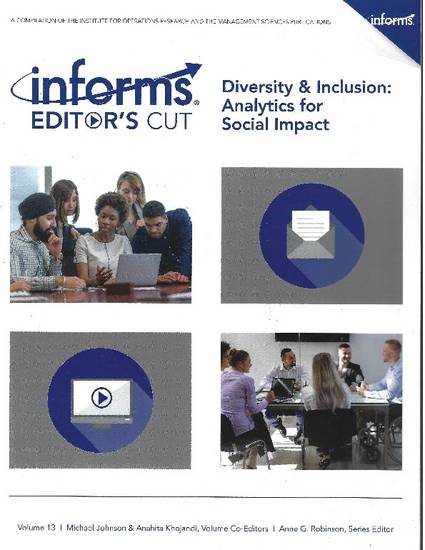
Book
INFORMS Editor's Cut: Diversity & Inclusion: Analytics for Social Impact
(2019)
Abstract
Diversity has recently become the Swiss Army Knife of policy, management, and practice in the United States, and in many other countries as well. The concept seems to fit perfectly into the language of modern politics, referring to plurality, harmony, exchange, tolerance, and fairness. Its main characteristic is an extreme sort of plasticity, which allows its users to connect the term to a wide range of ideas. It refers to all manner of difference: personal identity, professional practice styles, community characteristics.
This wide range of meanings cuts both ways: on one hand, it has legitimized the term; on the other hand, it may have emptied the term of "true" meaning or normative values. To understand how diversity can make a tangible difference in our society, we must address as well how organizations and societies can become, and be seen as, fair (‘equity’) and how our institutions can ensure that diversity and equity can persist and deepen over time and changes in social and economic circumstances (‘inclusion’).
In operations research, management science, and analytics, diversity, equity, and inclusion is often understood as primarily a topic of organizational design and management; however, it can also be viewed as a lens through which inquiry across many other application areas and analytic methods can be enriched. Diversity, equity, and inclusion can be viewed as a problem that the profession must solve (for example, enlarging the pipeline); however, it can also be viewed as a worldview that can transform the discipline and perhaps society at large.
This Editor's Cut highlights a number of especially interesting points of view, seeking to highlight outstanding case studies but also internal contradictions, because diversity can refer to completely different things in universities, political parties, or the business world. In information technology, diversity can help understand how different kinds of collaboration styles and roles are associated with project success. In management, diversity can help understand how leadership, human capital, and social capital are associated with organization success. In social policy, diversity can help understand how underrepresented and marginalized groups can benefit from programs and initiatives that respond to historic inequities, and better contribute to individual and community well-being. But can’t diversity, equity, and inclusion also help workgroups, firms, government, and communities to do better, and be better, by confronting difference, resolving conflict, establishing, and enforcing social norms and legal obligations, providing opportunity, helping to ensure beneficial outcomes?
Through academic research, professional practice, and community service, we hope that this collection of peer-reviewed journal articles, book chapters, magazine articles, webinars, videos, and podcasts can help all of us find our own way to put diversity, equity, and inclusion closer to the center of what we do in the decision sciences.
The complete volume is available online at https://pubsonline.informs.org/editorscut/diversity.
Keywords
- diversity,
- equity,
- inclusion,
- decision sciences,
- analytics,
- operations research,
- social impact
Disciplines
Publication Date
July, 2019
Editor
Anne G. Robinson
Publisher
Institute for Operations Research and the Management Sciences
Citation Information
Michael P Johnson and Anahita Khojandi. INFORMS Editor's Cut: Diversity & Inclusion: Analytics for Social Impact. Catonsville, MDVol. 13 (2019) Available at: http://works.bepress.com/michael_johnson/129/
